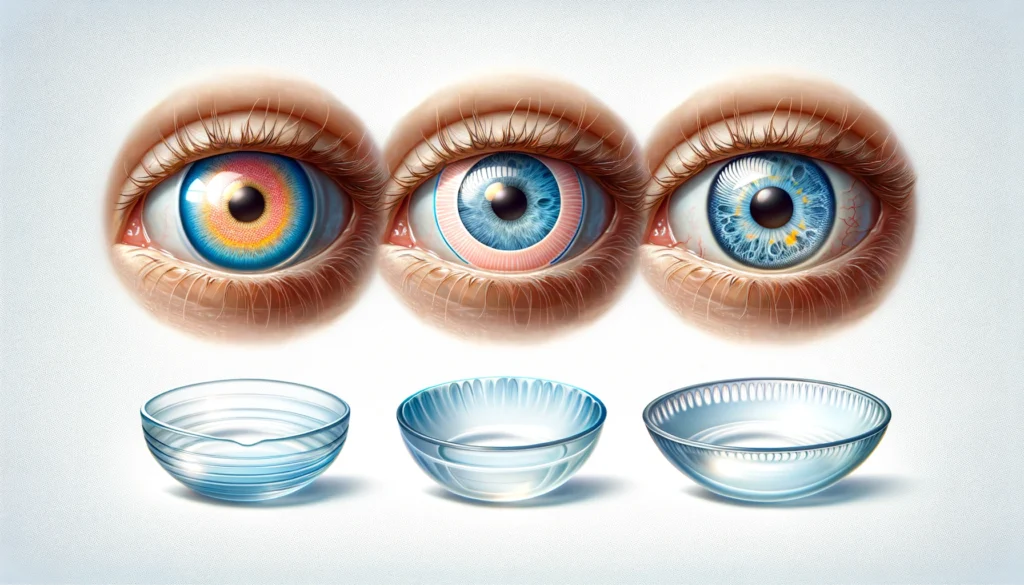Classification of Contact lens can be Based on Purpose of use, Anatomical Position, Materials used, Water Content percentage and Wearing Schedule.
Table of Contents
Contact Lens:
Contact lenses are medical devices used to correct vision, or for cosmetic or therapeutic reasons. Made from various materials, including soft hydrogel polymers and rigid, gas-permeable plastics, contact lenses are designed to fit the eye’s surface to correct refractive errors such as myopia (nearsightedness), hyperopia (farsightedness), astigmatism, and presbyopia.
Classifications of Contact Lens:
- Classification of Contact lens can be classified in 5 ways:
- Classification of Contact lens Based on Purpose.
- Based on Anatomical Position.
- Based on Materials.
- Based on Water Content.
- Based on Wearing Schedule.

1. Classification of Contact lens Based on Purpose of Use:
a. Optical Contact Lens:
- Optical contact lenses are designed primarily to correct vision by compensating for refractive errors such as: Myopia, Hyperopia, Astigmatism.
- These lenses function by focusing light directly onto the retina, improving visual clarity and overall vision quality.
b. Therapeutic Contact Lens:
- Therapeutic contact lenses are specialized lenses designed for medical treatments rather than vision correction.
- Use for therapy purpose like:
- Bandage Contact lens,
- Amblyopia therapy contact lens etc.
c. Cosmetic Contact Lens:
- Cosmetic contact lenses are designed to enhance or alter the appearance of the eyes rather than to correct vision.
- Tinted contact lenses can change or intensify the eye’s natural color, while special effect contact lenses are often used in the entertainment industry or for special occasions to create dramatic visual effects.
- These lenses offer a way for individuals to customize their appearance, whether for daily aesthetics or specific events.
d. Prosthetic contact lens:
- Prosthetic contact lenses are specially designed to improve the appearance of eyes that have been disfigured due to conditions such as:
- Aniridia (absence of the iris),
- Coloboma of the iris (a missing piece of the iris),
- Corneal opacity (scarring of the cornea).
- These lenses can mimic the appearance of a natural eye and are used both for cosmetic reasons and to help with light sensitivity in cases where the eye’s natural structures are compromised.
- They play a crucial role in enhancing the visual aesthetics and psychological well-being of individuals with eye disfigurements.
2. Based on Anatomical Position.
a. Scleral Contact Lens:
- These are large-diameter contact lenses that rest on the sclera, which is the white part of the eye. They can range from 15mm to 22mm in diameter.
- Scleral lenses are beneficial for patients with irregular corneas or severe dry eyes as they provide a smooth optical surface and can hold a tear reservoir beneath the lens.
b. Mini-scleral Contact Lens:
- These lenses are smaller than traditional scleral lenses but larger than Rigid Gas Permeable contact lenses.
- They rest on both the sclera and the cornea and have a diameter of up to 15mm.
- Miniscleral lenses offer a middle ground between the fit and comfort of scleral lenses and the easier handling of smaller corneal lenses.
c. Corneal Contact Lens:
- These lenses fit directly on the cornea and have a diameter that is generally less than the horizontal diameter of the cornea.
- Corneal contact lenses are commonly used for vision correction and are the type most people are familiar with.
3. Based on Materials.
a. Hard Contact Lens:
- These lenses are made from polymethyl methacrylate (PMMA) and are known for being rigid and durable.
- However, they do not allow oxygen to pass through to the cornea, which can lead to discomfort and is not ideal for corneal health during long wear periods.
b. RGP (Rigid Gas Permeable) Contact Lens:
- RGP lenses are also hard but they are made from materials such as siloxane acrylate or t-butyl styrene which allow oxygen to reach the cornea.
- This makes them more comfortable than traditional hard lenses and better for corneal health, while still providing the clear vision associated with rigid lenses.
c. Soft Contact Lens:
- These lenses are made from materials such as hydroxyethyl methacrylate (HEMA), silicone hydrogel, or other hydrogel materials, which are soft and flexible.
- They provide good oxygen supply to the cornea, making them comfortable to wear and suitable for extended use.
- Soft contact lenses are the most commonly prescribed type due to their immediate comfort and shorter adaptation period for the wearer.
4. Based on Water Content:
- The classification of contact lenses based on water content is primarily divided into two categories:
a. High Water Content Lenses:
- These lenses contain more than 50% water, reaching up to a maximum of 75%. High water content lenses are usually softer and more flexible, allowing for greater oxygen permeability which is beneficial for corneal health.
- However, they may dry out faster and could be less comfortable for people with dry eyes in certain environments.
b. Low Water Content Lenses:
- These lenses have less than 50% water content, going down to a minimum of 0%, which is referred to as ‘Zerogel’.
- Low water content lenses are generally more rigid and can be more effective for people with dry eyes as they retain moisture better and are less likely to dehydrate.
- They may also provide sharper vision and are often more resistant to deposit buildup.
5. Based on Wearing Schedule.
The classification of contact lenses based on wearing schedule can be divided into four categories:
a. Daily Wear Contact Lenses (CL):
- These lenses are intended to be worn during the day and then removed before sleeping.
- Typically, they can be worn for 8-12 hours per day.
b. Disposable Contact Lenses:
- These are designed for daytime use and are discarded after a single use before sleeping. They are not meant to be reused.
c. Extended Wear Contact Lenses:
- These lenses can be worn continuously, including overnight, for up to 6 nights and 7 days.
- After a one-night break, a new cycle of extended wear can begin.
d. Continuous Wear Contact Lenses:
- This type allows for the longest wear time, with the ability to be worn continuously for 29 nights and 30 days.
- After taking a one-night break, another cycle of continuous wear can be initiated.
Other Courses: Ophthalmic Instrumentation, Clinical Refraction, Contact Lens, Binocular Vision, Dispensing Optics, MCQs in Optometry
Download our App “Optometry Notes & MCQs” from Google Play Store.





3 Comments
This app in only available for Android Only.
Hello
I want to have the Optometry Notes and MCQs app and study with Smart Optometry. Could you please help me with how I can have the app on my iPad and online on my PC?
Very helpful post